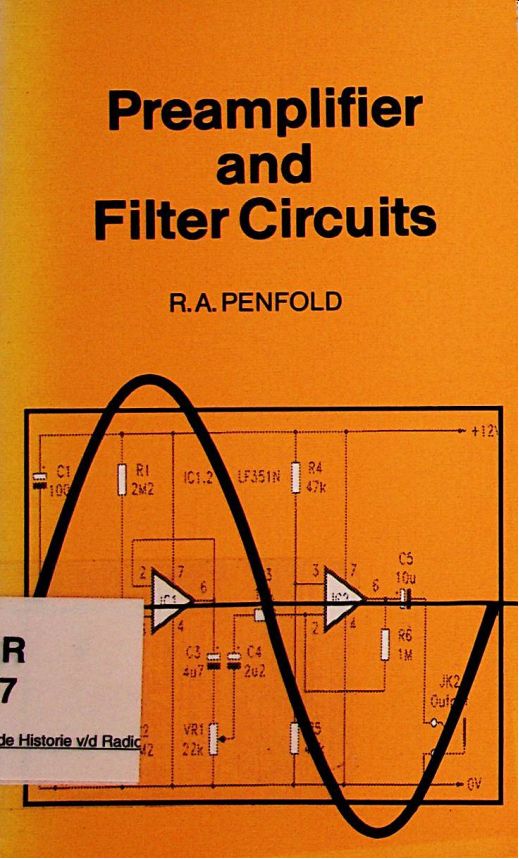| Home | Audio mag. | Stereo Review mag. | High Fidelity mag. | AE/AA mag. |
Section 1: PREAMPLIFIERS
Section 2: FILTERS, TONE CONTROLS, MIXERS, ETC.

Preface
[This guide adapted from 1991 book shown above]
In the world of hobby electronics over the last thirty years or so, several areas of interest have come into fashion only to fade away again. Going against the general run of things, the construction of audio equipment seems to have maintained its popularity over this entire period. It certainly seems to be as popular now as at any time in the past, except perhaps for the early seventies when hi-fi hit an exceptional peak of popularity. Audio is one aspect of electronic project building where it is still possible to build fairly simple but very useful devices which do not cost the proverbial "arm and a leg".
This guide is mainly intended for use in conjunction with "High Power Audio Amplifier Construction" (BP277), which contains designs for several power amplifiers having output powers of around 40 to 400 watts r.m.s. However, BP277 does not give details of any preamplifiers, tone controls, etc.
This guide provides circuits for several preamplifiers, tone controls, filters, mixers, etc., for use with power amplifiers such as those featured in BP277. It must be emphasized though, that these circuits should work equally well with any other power amplifiers, and they are quite definitely not exclusively for use with the power amplifiers in BP277.
No construction details are provided for the circuits featured in this guide, and it is not really intended for complete beginners. On the other hand, the circuits are all pretty simple, and you do not really need much previous experience of electronic project construction in order to tackle them. Where appropriate, any setting up procedures and notes on tricky aspects of construction are provided.
+++++
Rear Cover:
Preamplifier and Filter Circuits
This guide provides circuits and background information for a range of preamplifiers, plus tone controls, filters, mixers, etc. The use of modem low noise operational amplifiers and a specialist high performance audio preamplifier i.c. results in circuits that have excellent performance, but which are still quite simple. All the circuits featured can be built at quite low cost (just a few pounds in most cases).
The preamplifier circuits featured include:
Microphone preamplifiers (low impedance, high impedance, and crystal)
Magnetic cartridge pick-up preamplifiers with R.I.A.A. equalization
Crystal/ceramic pick-up preamplifier
Guitar pick-up preamplifier
Tape head preamplifier (for use with compact cassette systems)
Other circuits include:
Audio limiter to prevent overloading of power amplifiers
Passive tone controls
Active tone controls
PA filters (highpass and lowpass)
Scratch and rumble filters
Loudness filter
Audio mixers.
Volume and balance controls.
No construction details are provided for the circuits featured in this guide, and it is not really intended for complete beginners. On the other hand, the circuits are all pretty simple, and you do not really need much previous experience of electronic project construction in order to tackle them. Where appropriate, any setting up procedure [ … and …] aspects of construction are provided.
BERNARD BABANI BP309
++++
Also Available
HIGH POWER AUDIO AMPLIFIER CONSTRUCTION
BP277 R. A. Penfold £3.95
This guide provides background information on high power audio amplifiers, together with some practical designs capable of output powers of up to around 300 to 400 watts r.m.s.
The high power amplifier designs include types having power MOSFETS in the output stage. These give excellent performance over the full audio range, and offer good reliability from what are relatively simple circuits. Printed circuit designs are included for these power MOSFET circuits, as are suitable mains power supply designs.
a Using one of these power MOSFET amplifiers it is possible to obtain output powers of up to about 50 to 200 watts r.m.s. depending on the load impedance and the number of output devices used. By using two amplifiers (one inverting circuit and one non-inverting type) a bridge amplifier is produced, enabling very high output powers to be achieved (300 to 400 watts r.m.s. into a standard 8 ohm impedance load). e For those who prefer to use bipolar output transistors, inverting and non-inverting circuits are provided. These can be used in single-ended or bridge configurations, and provide comparable output powers to the power MOSFET designs.
0 85934 222 0 96
Pages 1991 178 x 111mm
Other Titles of Interest BP90 Audio Projects Audio
Audio Amplifier Construction Digital Audio Projects An Introduction to Loudspeakers and Enclosure Design Public Address Loudspeaker Systems Loudspeakers for Musicians Acoustic Feedback - How to Avoid It BP111 BP122 BP245 BP256 BP292 BP297 BP310
Also see:
Effectively Using the OSCILLOSCOPE
Major Solid State Audio hi-fi Construction Projects